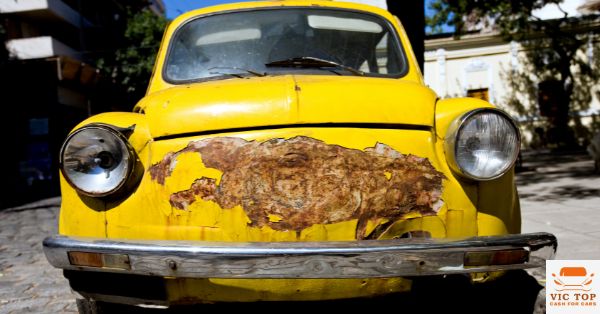We get this question A LOT. Rust is tricky and annoying and could make a difference when you’re trying to sell your car. Let’s break it down, folks.
how rust forms on vehicles
Rust isn’t just the result of age or moisture, it’s a chemical reaction. If you remember middle school science class, rust is iron oxide; a corrosion created when iron is exposed to oxygen and electrolytes at the same time. To create corrosion, you need a cathode (metal), electrolyte (salt), and anode (water). Due to the requirement of an electrolyte, vehicles in seaside towns and those that drive over salted winter roads are more likely to experience vehicle rusting problems.
The first requirement for your vehicle to rust is exposed metal. This means paint damage or damage to the sealant on your metal undercarriage. Once metal reaches the open air, any form of moisture in the form of liquid or even humidity in the air can start the rust corrosion process. When water and a salt form a mild acid, it begins eating away at the iron and moving electrons in a way that causes iron to turn into the fluffy, brittle oxide that is rust.
stages of rust corrosion
Rust comes in three stages—surface rust, scale rust, and penetrative rust. The amount of rust on your vehicle will determine what cleaning it will involve. The problem with rust is that it starts on the surface, which you think it’s a huge problem, right? But then it begins eating all the way through the iron and steel body of your vehicle, which is not good times.
First, it forms a powder, then it starts to bubble and expand out from the surface, lifting paint and spreading across the surface. Finally, it eats through into the core of the panel and can leave holes when completely cleared away.
surface rust
Surface rust is when a patina of rust just starts to form on your vehicle. This often starts in very small patches around tiny points of paint damage. A pebble chip, a scratch, or even extended UV exposure can cause a breakdown of the paint and allow rust to start forming.
Surface rust can fairly easily be sanded away and repainted, depending on how early you catch it and how much you have.
scale rust
Scale rust is when the damage starts to spread from the initial points of exposure. Rust is more expansive than steel, so will start to push the paint up and bubble as it spreads. Scale rust starts to go deeper into the surface of the metal and may leave pits and gaps when sanded away before repainting. Scale rust sometimes requires filler before you can repaint.
penetrative rust
Penetrative rust has actually eaten all the way through a panel. This has begun to break down the integrity of the vehicle and will need part replacement or patch panels in order to restore. You will need to reveal the holes by sanding and grinding out all the rust before the car can be repaired.
how to remove rust from your vehicle
So how do you get rust off your vehicle? Here are the steps that every rust cleaning and repair requires. NOTE: Be sure to follow all safety instructions that come with any power tools and chemicals. Eye protection and gloves are a great start. Rust removal may not be for someone with little experience using tools and working with metal.
sand and grind rust to bright metal
First, remove all the rust from your vehicle. This may require clearing away nearby paint to reveal the entire patch. Use sandpaper and grinders to clear away every bit of rust. Sand and grind down to the exposed bright metal.
apply rust inhibitor and rust converter
Next, you will need to apply a rust inhibitor followed by a rust converter. These are reactive chemical compounds that neutralize the current rust corrosion process and provide a temporary primer/sealant. Never double-dip or you will contaminate the bottle of rust-reactive chemicals.
fill and repair
For scale and penetrative rust, you may need to use a body filler in order to level out the areas where rust impacted the shape and texture of your car’s body. Once the rust converter is dry, fill your spaces with a body filler, using a little extra to compensate for the sanding you’ll do to restore the shape. Then let the filler set.
For penetrative rust, you will need to fully replace the rust-affected panels or apply metal patch panels to recover the integrity of the piece.
touch up the paint
Once the panel is completely rust-free, reformed, and cured; it’s time to repaint. With the right finishing paint, cars that have seen a little rust can often be good as new.
how to sell a rusty or rust-damaged vehicle
A little rust repair can go a long way to reselling your vehicle. But what if the rust damage can’t be repaired or must be replaced? This can happen with both scale and penetrative rust. If you just want to get the car off your hands without dealing with any of the hassle of removing rust, contact us.
We at VIC Top Cash For Cars, Always Ready to Assist You. Anytime. Everywhere. Any Day.
Our Services,
- Car Removal
- Cash For Cars
- Unwanted Car Removal Melbourne
- Cash For Scrap Car Removal Melbourne
- Old Car Removal Melbourne
If you are in Doveton, Victoria 3175 and looking for VIC Top Cash For Cars, below is the best way to visit us.
Contact us
VIC Top Cash For Cars,
2 Rochford Pl,
Narre Warren South VIC 3805
(03) 7035 7828
info@victopcashforcars.com.au


Recent Comments